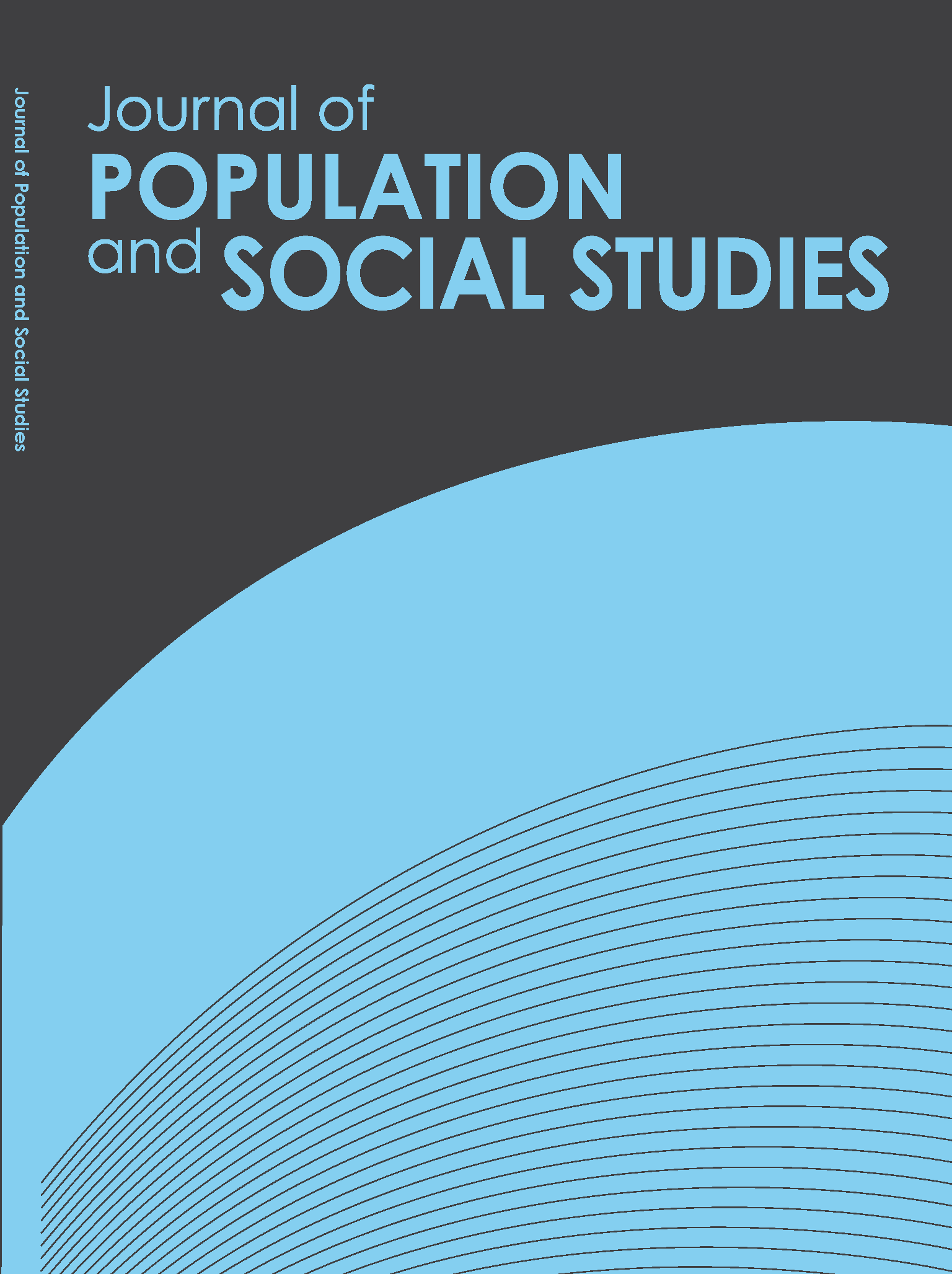Hypertension Stages and Their Associated Risk Factors among Adult Women in India
Main Article Content
Abstract
We investigated the prevalence of different stages of hypertension and their association with selected sociodemographic factors among adult women in India. The study used data from the WHO Study on Global Aging and Adult Health (SAGE) Wave I (2007). The respondents included women ages 18-49 (N=6,555) who provided complete information on their systolic and diastolic blood pressure along with body weight and height. Different stages of hypertension were characterized based on the American Heart Association (AHA) criteria. Mean arterial pressure (MAP) was also calculated by sociodemographic characteristics and nutrition level of the respondent. Multinomial regression analysis was performed to assess the adjusted and unadjusted effects of BMI levels on hypertension. Overweight women compared to the other women were 60% more likely to have pre-hypertension and were at 82% and 83% higher risk to have Hypertension Stage 1 and Stage 2 respectively after controlling for confounding factors. The prevalence of hypertension was significantly higher in tribal, poor, Sikh and older women, as well as for those consuming alcohol and tobacco. The results of the study indicate that early diagnosis and treatment of hypertension must be encouraged particularly in low-income settings, and that information, education and communication (IEC) programs focusing on healthy diet and lifestyle should be promoted.
Article Details
References
American Heart Association. (n.d.). Understanding blood pressure readings. Retrieved from http://www.heart.org/HEARTORG/Conditions/HighBloodPressure/AboutHighBloodPressure/Understanding-Blood-Pressure-Readings_UCM_301764_Article.jsp
Anchala, R., Kannuri, N. K., Pant, H., Khan, H., Franco, O. H., Di Angelantonio, E. & Prabhakaran, D. (2014). Hypertension in India: A systematic review and meta-analysis of prevalence, awareness, and control of hypertension. Journal of Hypertension, 32(6), 1170-1177. doi: http://dx.doi.org/10.1097/HJH.0000000000000146
Basu, S. & Millett, C. (2013). Social epidemiology of hypertension in middle-income countries: determinants of prevalence, diagnosis, treatment, and control in the WHO SAGE study. Hypertension, 62(1), 18-26. doi: https://doi.org/10.1161/hypertensionaha.113.01374
Bell, C. N., Bowie, J. V. & Thorpe, R. J. (2012). The interrelationship between hypertension and blood pressure, attendance at religious services, and race/ethnicity. Journal of Religion and Health, 51(2), 310-322. doi: http://dx.doi.org/10.1007/s10943-010-9346-7
Chakraborty, R., Bose, K. & Bisai, S. (2009). Body mass index and blood pressure among adult Bengalee male slum dwellers of Kolkata, India. Journal of Public Health, 17(5), 301-308. doi: http://dx.doi.org/10.1007/s10389-009-0254-9
Cnossen, J. S., Vollebregt, K. C., de Vrieze, N., ter Riet, G., Mol, B. W. J., Franx, A., … van der Post, J. a M. (2008). Accuracy of mean arterial pressure and blood pressure measurements in predicting pre-eclampsia: Systematic review and meta-analysis. BMJ (Clinical Research Ed.), 336(7653), 1117-20. doi: http://dx.doi.org/10.1136/bmj.39540.522049.BE
Davy, K. P. & Hall, J. E. (2004). Obesity and hypertension: Two epidemics or one? American Journal of Physiology. Regulatory, Integrative and Comparative Physiology, 286(5), R803-R813. doi: http://dx.doi.org/10.1152/ajpregu.00707.2003
Dumler, F. (2009). Dietary sodium intake and arterial blood pressure. Journal of Renal Nutrition: The Official Journal of the Council on Renal Nutrition of the National Kidney Foundation, 19(1), 57-60. doi: http://dx.doi.org/10.1053/j.jrn.2008.10.006
Farag, Y. M., Mittal, B. V., Keithi-Reddy, S., Acharya, V. N., Almeida, A. F., C, A., … Singh, A. K. (2014). Burden and predictors of hypertension in India: results of SEEK (Screening and Early Evaluation of Kidney Disease) study. BMC Nephrology, 15(1), 42. doi: http://dx.doi.org/10.1186/1471-2369-15-42
Garawi, F., Devries, K., Thorogood, N. & Uauy, R. (2014). Global differences between women and men in the prevalence of obesity: Is there an association with gender inequality? European Journal of Clinical Nutrition, 68(10), 1101-1106. doi: http://dx.doi.org/10.1038/ejcn.2014.86
Gupta, R. (2004). Trends in hypertension epidemiology in India. Journal of Human Hypertension, 18(2), 73-78. doi: http://dx.doi.org/10.1038/sj.jhh.1001633
Gupta, R. (2013). Prevention & control of CVD in women & children in India. The Indian Journal of Medical Research, 9, 281-284. Retrieved from https://www.ncbi.nlm.nih.gov/pmc/articles/PMC3818587/
Hajat, A., Kaufman, J. S., Rose, K. M., Siddiqi, A. & Thomas, J. C.
(2010). Do the wealthy have a health advantage? Cardiovascular disease risk factors and wealth. Social Science & Medicine (1982), 71(11), 1935-1942. doi: http://dx.doi.org/10.1016/j.socscimed.2010.09.027
Hazarika, N., Biswas, D. & Mahanta, J. (2003). Hypertension in the elderly population of Assam. Journal-Association of Physicians of India, 51, 567-573. Retrieved from japi.org/june2003/O-567.pdf
Ibrahim, M. M. & Damasceno, A. (2012). Hypertension in developing countries. The Lancet, 380(9841), 611-619. doi: http://dx.doi.org/10.1016/S0140-6736(12)60861-7
International Institute for Population Studies (IIPS). (2007). National
Family Health Survey (NFHS-3), 2005-06 (Vol. I). Mumbai. Retrieved from http://scholar.google.com/scholar?hl=en&btnG=Search&q=intitle:National+family+health+survey+(nfhs-3)+2005–06#2
Kearney, P. M., Whelton, M., Reynolds, K., Muntner, P., Whelton, P. K. & He, J. (2005). Global burden of hypertension : Analysis of worldwide data. Lancet, 365(9455), 217-223. doi: https://doi.org/10.1016/s0140-6736(05)17741-1
Kuc, S., Koster, M. P. H., Franx, A., Schielen, P. C. J. I., & Visser, G. H. A. (2013). Maternal characteristics, mean arterial pressure and serum markers in early prediction of preeclampsia. PloS One, 8(5), e63546. doi: http://dx.doi.org/10.1371/journal.pone.0063546


